PERIKLES (c. 490–429 BC) Ancient Greek politician, strategist...

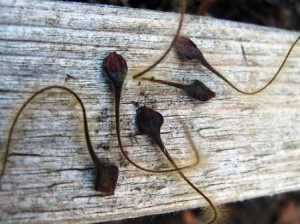
Only in Antarctica there are no clematis from the buttercup family yet. But to plant clematis in your garden so that a flowering, eye-pleasing plant grows from seeds, even a novice florist is quite capable of. To begin with, you will have to choose between a herbaceous, semi-shrub and shrubby type of clematis, most of which are included in the liana group.
Clematis cultivation is carried out by seeds and vegetatively. Seed propagation is used for small-flowered plants with a flower size up to 6 cm in diameter. They compare favorably with unpretentiousness and an abundance of greenery. Flowering is also plentiful, and in autumn the bushes are decorated with original seed heads. By choosing a variety of clematis for planting with seeds and establishing decent care for the plant, you are almost guaranteed to get an excellent result. When self-collecting seeds for subsequent propagation, it should be borne in mind that small-seeded varieties ripen for this 1-2 months after flowering, and large-seeded varieties - after 2.5-4 months.
Did you know? For plants from any seeds, care is standard.
 The inflorescences of almost all small-seeded clematis species are resistant to frost. Therefore, even the middle of winter is suitable for collecting small (0.1 x 0.3 cm - 0.3 x 0.5 cm) seeds. Seeds that have not fallen over the winter can be harvested in the spring. After planting, the seeds germinate in three weeks, but there are varieties in which this period takes up to 4 months. Within two years, germination is considered guaranteed.
The inflorescences of almost all small-seeded clematis species are resistant to frost. Therefore, even the middle of winter is suitable for collecting small (0.1 x 0.3 cm - 0.3 x 0.5 cm) seeds. Seeds that have not fallen over the winter can be harvested in the spring. After planting, the seeds germinate in three weeks, but there are varieties in which this period takes up to 4 months. Within two years, germination is considered guaranteed.
Although the germination period of medium (0.3 x 0.5 cm - 0.5 x 0.6 cm) seeds can last up to six months, they generally germinate in a coordinated manner already 45 days after sowing. For them, stratification is mandatory, after which germination remains for another three years.
Seeds with dimensions of at least 0.5 x 0.6 cm and up to 1 x 1 cm are considered large. Their germination period can reach a year, which is why such varieties of clematis are more often propagated by cuttings. Germination of large seeds lasts up to 4 years.
Important! Release large seeds from the hard shell - germination will accelerate.
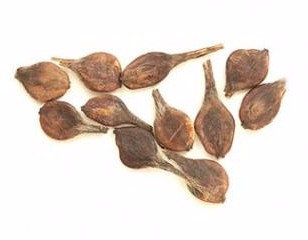 With a large number of seeds sown directly in open ground in the end of April. In the case of a poor harvest, it is better to sow small seeds first, in February-March, in containers with garden soil located indoors in order to get seedlings. Sowing dates for seedlings of seeds of other sizes fall in the fall due to the unhurried pace of their subsequent germination.
With a large number of seeds sown directly in open ground in the end of April. In the case of a poor harvest, it is better to sow small seeds first, in February-March, in containers with garden soil located indoors in order to get seedlings. Sowing dates for seedlings of seeds of other sizes fall in the fall due to the unhurried pace of their subsequent germination.
For clematis, loose sandy or loamy soil, well saturated with humus, is most suitable. A regularly moistened soil mixture of earth, humus, sand and ash is considered optimal for future seedlings.
Important! Good drainage must be provided.
Hardening of seed material (stratification) is carried out in different ways, depending on when it is supposed to sow clematis seeds. It is not recommended to plant without this procedure, as this can adversely affect the germination of seeds and the subsequent disease resistance of seedlings.
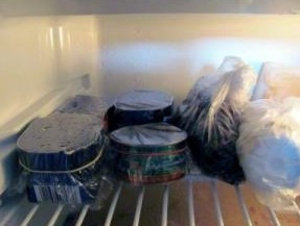 Usually, low temperatures are used for stratification, simulating the natural habitat of plants. During the winter sowing of clematis with seeds, for example, the seed material is preliminarily kept for 2-3 weeks in the refrigerator, reproducing the conditions when the seeds hibernate under the cover of foliage and snow. If spring planting is planned, then it is enough to create a dark place and a temperature of +5 ° C for the maintenance of seeds.
Usually, low temperatures are used for stratification, simulating the natural habitat of plants. During the winter sowing of clematis with seeds, for example, the seed material is preliminarily kept for 2-3 weeks in the refrigerator, reproducing the conditions when the seeds hibernate under the cover of foliage and snow. If spring planting is planned, then it is enough to create a dark place and a temperature of +5 ° C for the maintenance of seeds.
Important! Stratification is carried out even in the snow.
The bubbling method is used to improve seed germination. Constantly changing water, in which the seeds are soaked for 5-7 days before sowing, is enriched with oxygen, using a standard aquarium aerator for 5-6 hours.
Experienced flower growers can tell you how to plant clematis with seeds so that the sowing is close to ideal - the planting depth must be calculated based on three times the size of the seed, and a layer of river sand should be poured and lightly tamped over it, through which the thrown shoot will easily come out. How to plant clematis seeds in some cases, three of the most famous methods tell.
After sprinkling the seeds with sand, the container where they are located is covered with glass and installed until planting in the greenhouse, where a constant temperature of 20 ° C is maintained. Seedlings that appear after a few months are planted in open ground at the end of summer.
In the humus, which is filled with plastic dishes, seeds are planted in the fall. After that, the container is covered with a film and placed in the dark. Sprouts that germinate after a few months are first planted in boxes, and in July they move to open soil. Half a meter intervals are observed between seedlings.
The seeds of one of the climbing varieties of clematis are planted in jars using this method, and after 90 days they are placed in the refrigerator. Practical experience shows a 90% increase in seed germination in spring.
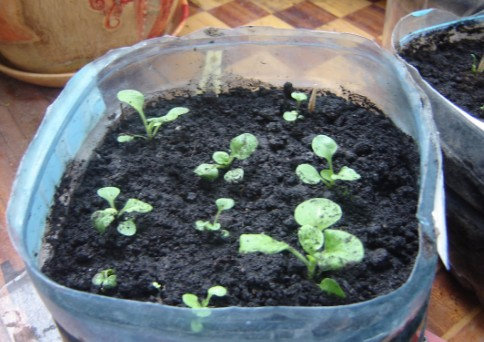 You can expect good seedlings of clematis from sown seeds with more confidence if you use special boxes for growing. For their placement in the winter, a loggia or window sill is suitable, and with the onset of spring, you can expose them to the natural environment. Having received seedlings with a couple of true leaves, you can start diving into separate pots and continue your usual care at home until the cold finally passes.
You can expect good seedlings of clematis from sown seeds with more confidence if you use special boxes for growing. For their placement in the winter, a loggia or window sill is suitable, and with the onset of spring, you can expose them to the natural environment. Having received seedlings with a couple of true leaves, you can start diving into separate pots and continue your usual care at home until the cold finally passes.
The movement of clematis to the place of permanent deployment depends on when the seeds began to be planted on seedlings. Autumn sowing means that the plants will be ready for open ground by mid-spring, since, due to their youth, they may not survive the winter in it. A semi-annual, at least, gap between sowing and planting in the soil is also needed in the spring-autumn scheme. Clematis planted in the pre-winter months are insulated with foil or straw until spring. Did you know? If you continue to care for unsprouted seeds, then after 8 months they will germinate.
Small-flowered clematis in most cases are planted from seeds, and planting and caring for them are fairly standard for all varieties. Seed material is freely sold in specialized stores. It is not difficult and self-collection. Plants growing from seeds bear fruit well, providing new planting material, which, by the way, is often used as winter-hardy rootstocks for grafting valuable warm-loving flowers.
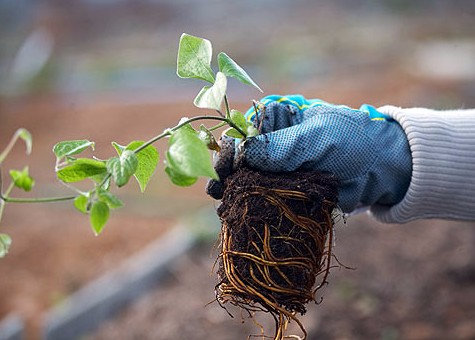 The main disadvantage of breeding clematis from seeds is the relatively high laboriousness of the procedure, which requires increased care and considerable trouble. As a less significant unpleasant feature of this method, there is no guarantee that the grown clematis will retain the best properties of the parent flower.
The main disadvantage of breeding clematis from seeds is the relatively high laboriousness of the procedure, which requires increased care and considerable trouble. As a less significant unpleasant feature of this method, there is no guarantee that the grown clematis will retain the best properties of the parent flower.
The labor spent on growing charmingly beautiful clematis fully pays off with the charm of the garden decorated with them.
Was this article helpful?
Not really
Reproduction of clematis by seeds is the main way by which you can increase the collection of species plants and develop new varieties. Seeds of clematis are divided by size into large and rather small. It has been established that the duration of their germination depends on the size of the seeds.
Clematis with small seeds germinate quickly and amicably, which cannot be said about large-seeded species and varieties. Note that large-seededness is not related to the size of the flower.
Clematis sprawling, woolly, Jacqueman with flowers with a diameter of 10-25 cm and forest clematis, Pitcher with flowers with a diameter of 1.5-2 cm have large seeds.
It was experimentally revealed that in large-seeded species the embryo is underdeveloped and therefore it takes time to complete its formation, and so that the seeds do not germinate ahead of time, their shell contains substances of a strong physiological inhibition mechanism.
The period after harvest ripening is directly proportional to the size of the seeds and lasts from 15 days to 20 months. The mass of a thousand clematis seeds ranges from 0.2 to 30.2 g, and their size is 1.5-12 mm.
For propagation of clematis, its seeds can be collected independently. It should be noted that small-seeded clematis species produce ripened seeds 1-2 months after flowering, while for large-seeded clematis, this process takes 2.5-4 months.
In Belarus, all types of clematis, except those that bloom in September, bear fruit, but the seeds, especially those of late-flowering ones (borscht-wikoleaf, short-tailed, serrated, Reder) do not ripen annually.
Among the large-flowered seeds ripen in varieties that bloom before July 15th. They are collected when they turn brown, and the seedlings crumble when touched. In brown, forest, purple clematis, this is done before frost, in early October.
In small-seeded, frost-resistant, with dense seedlings (K. vine-leaved, serrated-leaved, Tangut), seeds can be collected even in the middle of winter, and if they have not fallen off, then in spring. Before sowing, they are stored in a cool, dry place.
Small seeds are sown at the end of April, in open ground to a depth of about 1 cm. Seedlings, depending on the species, appear on the 18-40th day. If there are not many seeds, it is better to sow them in March-April in boxes with fertile garden soil in a greenhouse or in a room.
In the same way, the seeds of K. Manchurian and K. whole-leaved are sown, which germinate no earlier than after 2 months.
In large-seeded clematis, in order to remove the physiological mechanism of inhibition, apply various ways. In particular, they are soaked for 3 days in warm water, which is changed 2-3 times a day.
Aeration has a positive effect on this. Sometimes it is recommended to soak the seeds for 7-10 days. In my opinion, they may lose their germination. Treatment with heteroauxin at a concentration of 1 mg / l, vitamin B, multivitamins, glucose 0.1-0.15% will help speed up the emergence of seedlings of large-seeded clematis. As well as the juice of the green parts of the plant and the extract from the seeds of clematis, characterized by rapid germination at a concentration of 0.5%. Seed stratification also has a positive effect.
They are sown immediately after collection in boxes and kept all winter in greenhouses. In this case, the seedlings are stretched and germinate from March to winter. With a small amount of seeds, you can free them from the shells manually. This speeds up germination.
It has been established that the seeds germinate best when the substrate has a moisture content of 70-80% of the total moisture capacity and a temperature of + 25-30 degrees. Ascended seedlings also love light, heat, humidity and develop better when the surface part is shaded. Very good for this purpose is sphagnum moss, which covers the soil in crops.
Young plants in the stage of cotyledon leaves or the appearance of the first true leaf dive into boxes or beds with light soil and put in a shaded place.
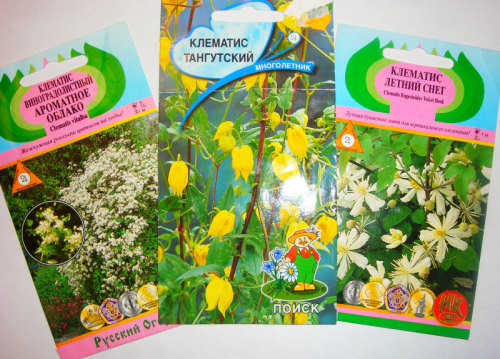
The distance between plants during picking should be 15-20 cm. Some flower growers recommend diving with 3-4 true leaves, but in this case the survival rate is worse and seedlings die more than with early picking.
If you have to plant such seedlings, then they need to be covered with a film. With rare shoots, picking can be omitted.
Strengthened seedlings are planted in open ground on cool days - from May to the end of July. Planted plants are pinched over the second pair of leaves, which contributes to better branching.
Seedlings growing in open ground are planted the following spring after germination. By autumn, the ascended seedlings reach 10-50 cm in height. Clematis flowering in the year of sowing is not observed in Belarus.
But when growing seedlings under a film and on a very high agricultural background, they can bloom in the first year. Care consists of watering and fertilizing. The first time they are fed with urea (1 tsp per bucket of water).
Then every 15 days - mullein (1:20) or a mixture mineral fertilizers(2 tsp per bucket of water). For the winter, seedlings need to be covered. Only a few species, for example, Tangut clematis, endure the first winter without shelter.
In the spring of the following year, seedlings are planted at a distance of 50 cm from each other in trenches 40 cm deep, filled with fertile soil. Young plants are buried by 3-5 cm. Shoots are shortened to 2-3 lower nodes. Without shortening the shoots, seedlings of many species, especially on poor soils, look like bushes with small branches.
In the second year, most small-seeded species bloom. Large-seeded species and varieties bloom in the 3-4th year of life. After the first flowering, young clematis are planted in a permanent place.
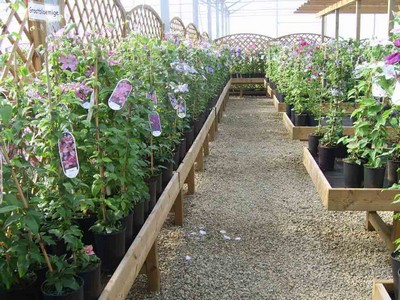
When choosing a place for planting clematis, you need to take into account that in Belarus clematis develop well only in sunny places. This is especially true for species and varieties that bloom in the second half of summer. The soil for planting is improved by the application of organic and mineral fertilizers.
The best planting time is autumn, because. in clematis at the end of August, an autumn wave of root growth is observed. Seedlings are planted, deepening up to 10 cm. Care - fertilizer, pruning - is the same as for adult plants. When clematis grown from seed blooms, you will certainly want to repeat this process.
The size of their seeds is 2-3 mm. The cotyledons are above the soil surface, the roots are woody.
Seed size - from 4 to 5 mm. The cotyledons are on the surface, the roots are cord-like, soft, without root hairs.
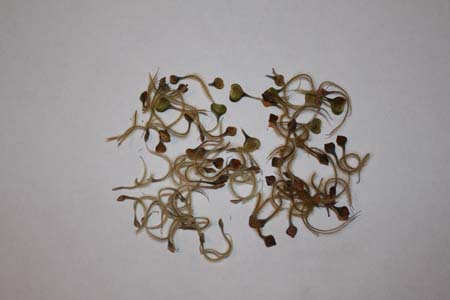
This includes large-flowered varieties. Seed size - from 5 to 12 mm. Seedlings of this group have cotyledons in the soil. Roots cord-like, soft, without root hairs.
Clematis (aka clematis) has many adherents among flower growers around the world. This plant can become a magnificent decoration of any personal plot, park, square. Many varieties of crops growing in containers, large pots feel great on terraces, balconies, loggias.
 A competent approach to planting clematis will be the key to its rapid rooting, growth, flowering during the first year. There are many inexperienced gardeners who are confident that growing clematis from seeds at home is quite problematic. As a result, some flower growers are trying to purchase ready-made young plants from sellers in the market, in specialized stores.
A competent approach to planting clematis will be the key to its rapid rooting, growth, flowering during the first year. There are many inexperienced gardeners who are confident that growing clematis from seeds at home is quite problematic. As a result, some flower growers are trying to purchase ready-made young plants from sellers in the market, in specialized stores.
In order for the cultivation of clematis from seeds at home to be successful, you need to know the rules for obtaining, sorting, processing planting material.
It is noteworthy that in various varieties, hybrids of culture, seed collection is carried out at certain periods (summer, autumn). Seeds of plants representing different species can vary significantly in size. 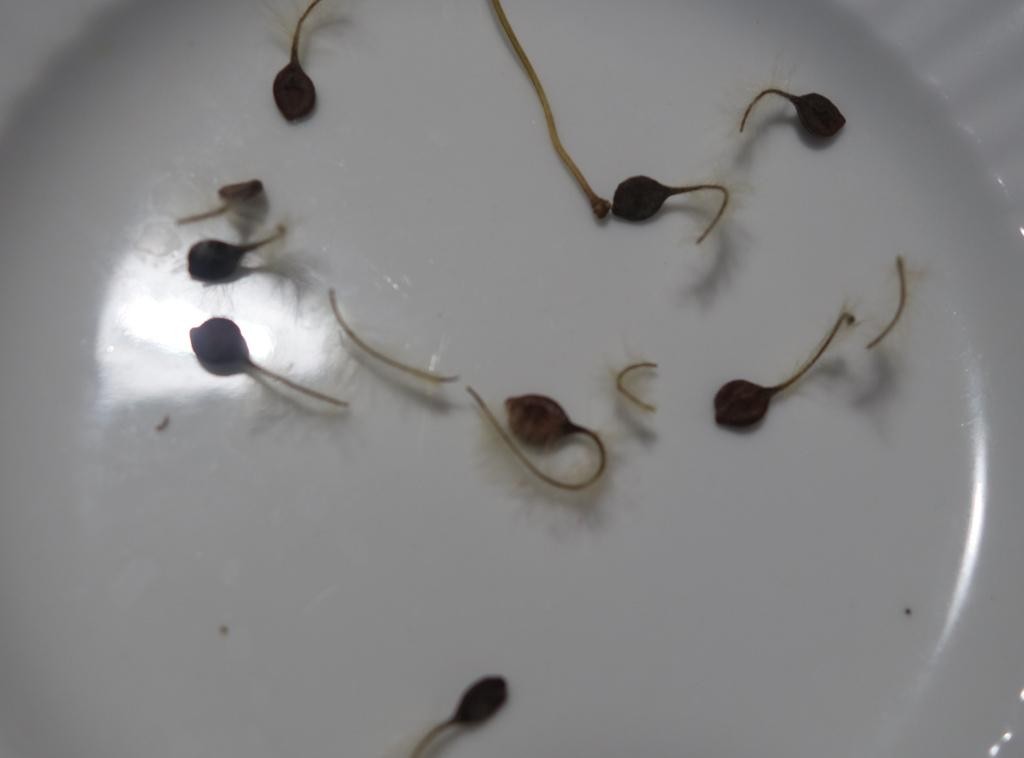 Small, medium, large seeds can also be obtained from one bush.
Small, medium, large seeds can also be obtained from one bush.
Small-seeded clematis species show resistance to frost. For their collection, it is worth preferring the middle of winter. The germination period of such planting material, on average, is 3 weeks. Medium-sized seeds, as a rule, germinate in 45 days. They need mandatory stratification. Large seeds take the most time to germinate, however, they have the best germination.
Initially, you will need to sort out planting material. As practice shows, the propagation of clematis by seeds at home will be most effective when using seeds of large, medium sizes. Alternatively, you can purchase seed material at a specialized outlet.
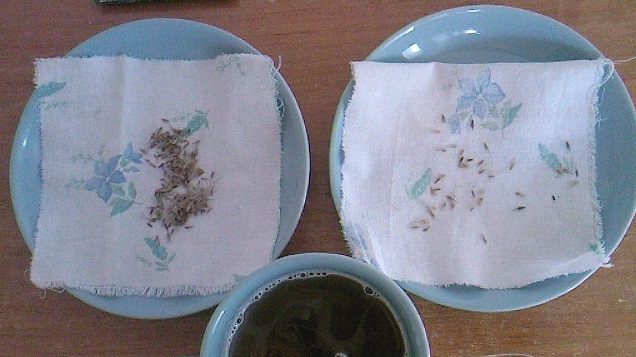 Sowing can be scheduled for spring or autumn. The flower grower will not be mistaken if he first performs such a procedure as stratification of clematis seeds at home, which ensures an increase in the germination of seedlings, obtaining strong, healthy seedlings that are resistant to diseases.
Sowing can be scheduled for spring or autumn. The flower grower will not be mistaken if he first performs such a procedure as stratification of clematis seeds at home, which ensures an increase in the germination of seedlings, obtaining strong, healthy seedlings that are resistant to diseases.
Carrying out spring sowing involves the creation of optimal storage conditions for planting material. To do this, the seeds must be placed in a dark place, ensuring that the temperature is maintained at + 5 ° C. When choosing an autumn planting, they must first be placed in the refrigerator for 2 - 3 weeks. Such procedures will contribute to the hardening of seeds, which will increase the resistance of young plants to adverse weather conditions.
Flower growers with experience try to perform seed sparging to improve their germination. Carrying out such an event involves soaking the planting material for 5-7 days in constantly changing water enriched with oxygen. For this, the use of a standard aquarium aerator is practiced.
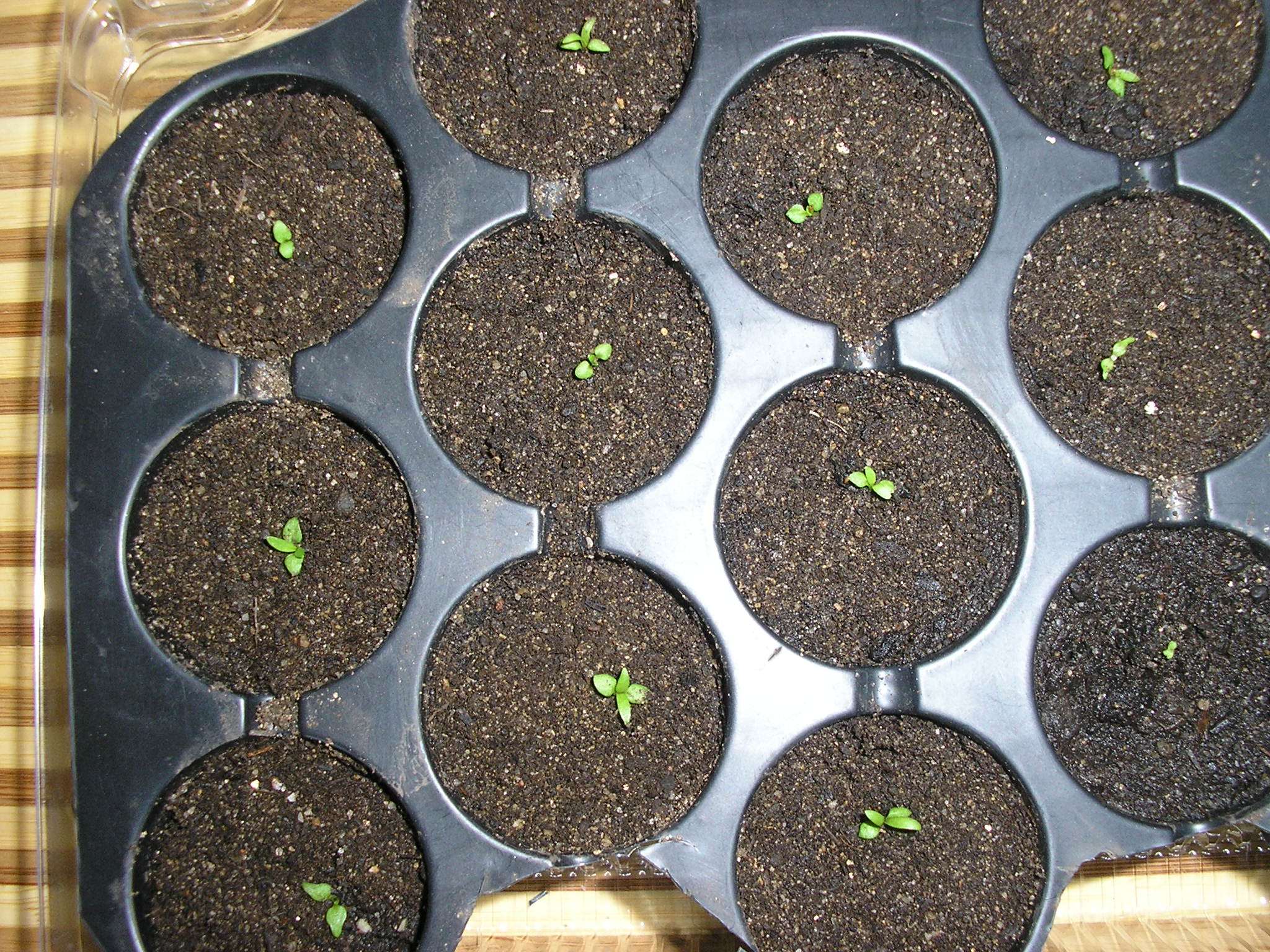 A florist who knows how to plant clematis seeds at home will definitely prepare suitable containers for seedlings and fill them with a nutritious soil mixture, which will include humus, earth, sand, and ash.
A florist who knows how to plant clematis seeds at home will definitely prepare suitable containers for seedlings and fill them with a nutritious soil mixture, which will include humus, earth, sand, and ash.
It takes up to 3 months for seedlings to germinate (depending on the variety chosen, indoor microclimate). During the seed spitting period, it is necessary to ensure that the soil is maintained in a moist state, avoiding stagnant water.
Without proper experience, for the first time it is worth trying to grow Manchurian clematis from seeds, since this crop is characterized by high germination of crops. Having gained valuable skills, in the future you can plant other varieties, plant hybrids.
It is recommended to place the seeds of the culture in the soil to a depth that exceeds their size by 2-3 times. Next, the soil is covered with clean river sand, slightly compacted. Below are the most popular sowing methods.
A container with seeds sprinkled with a layer of sand is covered with a film or glass, and then determined in a place with a constant temperature of + 20 ° C. The grown seedlings are to be planted in open ground at the end of the summer season.
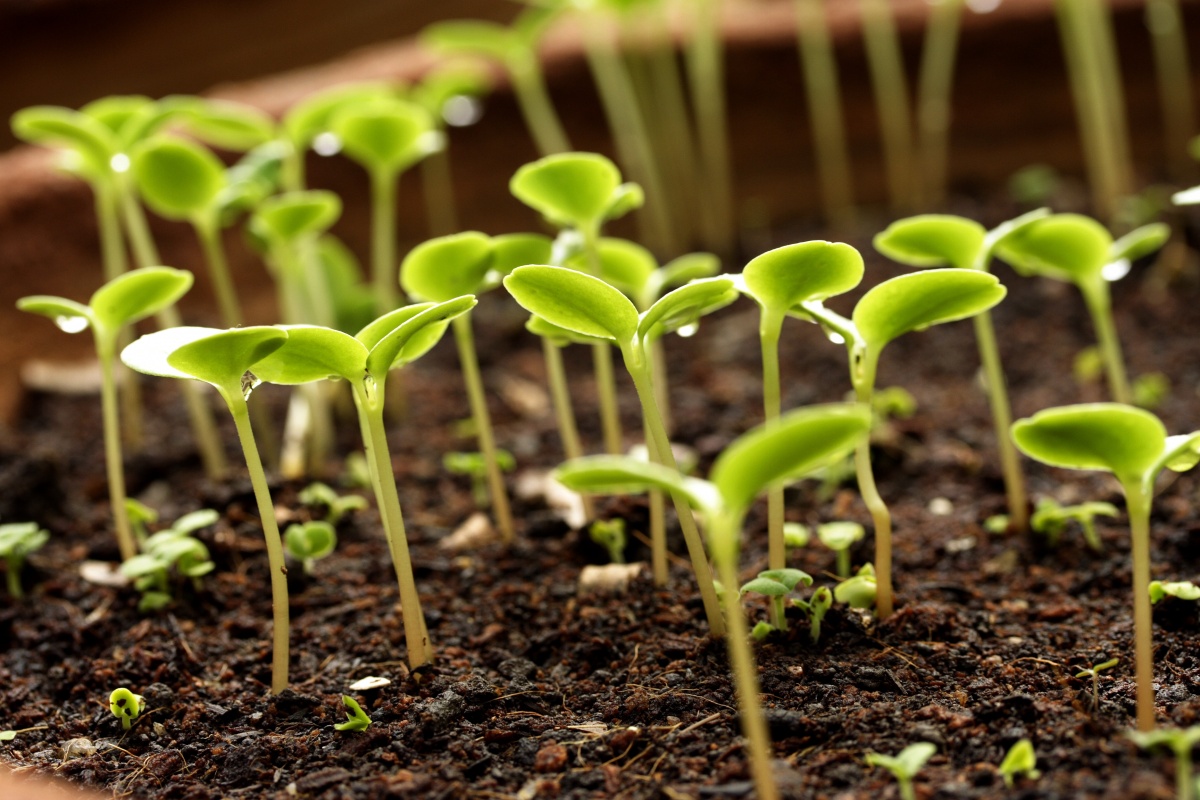
Clematis seedlings
In a plastic container in the fall, you need to sow the seeds. Next, the container should be covered with a film, placed in a dark place. The seedlings that have appeared must be planted in separate pots, and in July, determined in open ground with an interval of 0.5 m.
A jar of seeds is placed in the refrigerator for 3 months. In spring, the extracted planting material shows a significant increase in germination (by 90%).
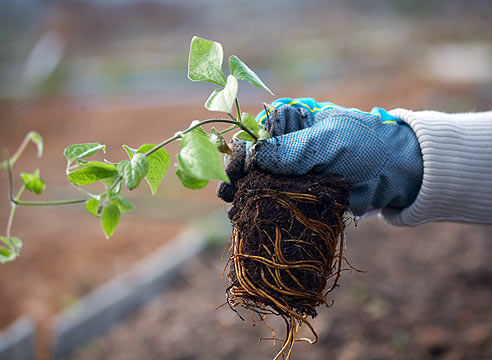 Seedlings of clematis culture: planting from seeds at home which was carried out in the fall, transplanted into the ground in mid-spring. The gardener will need to decide on the timing of planting young plants at the beginning of the year in order to prevent damage to them by sudden frosts.
Seedlings of clematis culture: planting from seeds at home which was carried out in the fall, transplanted into the ground in mid-spring. The gardener will need to decide on the timing of planting young plants at the beginning of the year in order to prevent damage to them by sudden frosts.
Spring sowing will allow you to get seedlings suitable for planting in a permanent place only in the fall. If desired, young clematis Lomonos should be held until next spring. Many gardeners try to plant seedlings in the fall in order to enjoy beautiful flowers in the spring. For such plants, it is necessary to provide a reliable shelter (straw, film) in order to exclude their death from frost.
When choosing a place for planting clematis, you will need to give preference to a well-lit area protected from the winds. At the same time, the root part of the plant needs shade. A prudent gardener will provide a planted crop with a reliable support.
A flower grower who has thought about choosing the most suitable types of clematis suitable for seed breeding should first obtain detailed information about the varieties of interest. This will allow you to assess the prospects for their cultivation, will make it possible to make a final decision in favor of certain plants. Below is an overview of varieties, clematis hybrids, the study of which will certainly be useful and interesting.
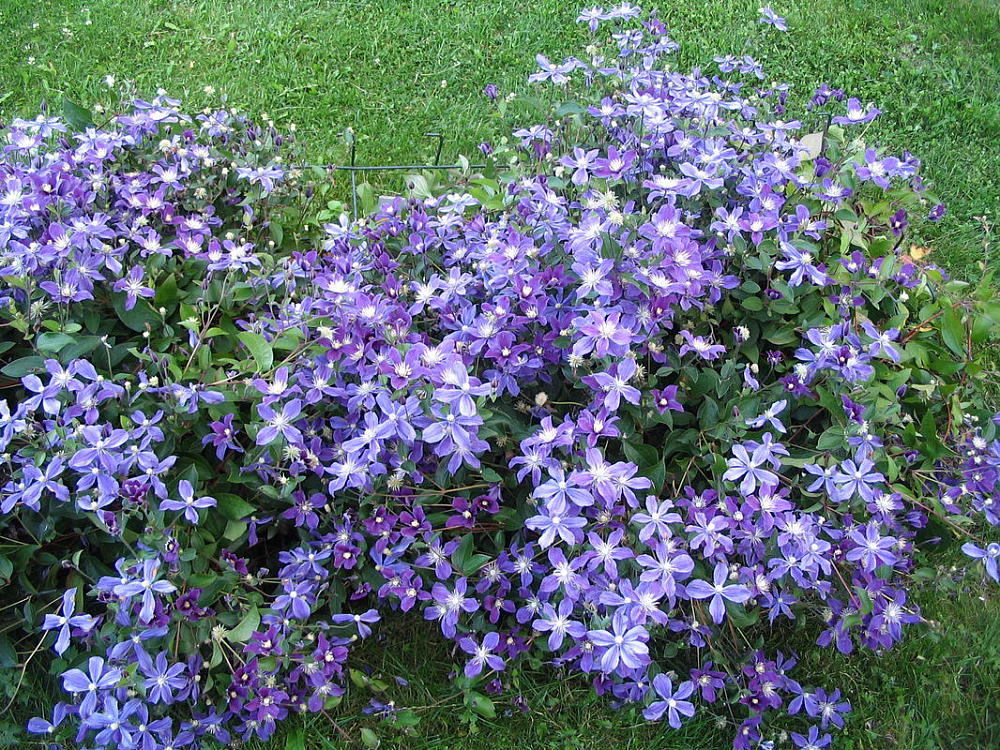 Unpretentious late-flowering, large-flowered clematis Arabella is trying to plant many flower growers. Its stems in growth reach a length of 1.5 m. Looking through reviews of clematis Arabella, you should pay attention to the abundant, long flowering of the culture (May - September).
Unpretentious late-flowering, large-flowered clematis Arabella is trying to plant many flower growers. Its stems in growth reach a length of 1.5 m. Looking through reviews of clematis Arabella, you should pay attention to the abundant, long flowering of the culture (May - September).
The flowers of the plant (10 cm in diameter) are blue-violet with a peculiar gray tint. During the season, they change color to blue. Floral stamens are creamy yellow. Arabella is a wonderful ground cover clematis. It can be planted near shrubs, trees, obelisks.
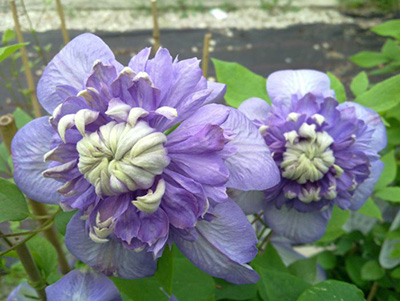 Early, large-flowered Clematis BlueLight attracts the eye with many light blue, double flowers. Shoots of culture 2 m long have the ability to cling to supports with the help of leaf petioles. The plant is guaranteed to decorate any fence, gazebo, trellis, garden support. Clematis Blue Light can also cling to deciduous, coniferous shrubs.
Early, large-flowered Clematis BlueLight attracts the eye with many light blue, double flowers. Shoots of culture 2 m long have the ability to cling to supports with the help of leaf petioles. The plant is guaranteed to decorate any fence, gazebo, trellis, garden support. Clematis Blue Light can also cling to deciduous, coniferous shrubs.
The culture is in perfect harmony with plants that have yellow leaves or flowers. Blue Light blooms twice: in May - June, August - October, suitable for container growing.
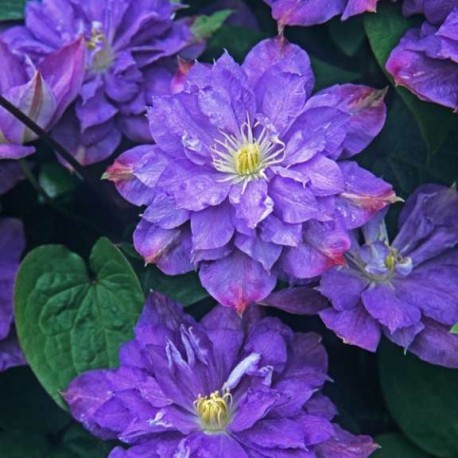 Bred by Polish breeders, large-flowered, early clematis Blue Explosion fascinates with the charm of many large, blue, tinted pink flowers (from 12 cm in diameter). The stems of the plant are up to 3 m long.
Bred by Polish breeders, large-flowered, early clematis Blue Explosion fascinates with the charm of many large, blue, tinted pink flowers (from 12 cm in diameter). The stems of the plant are up to 3 m long.
The culture shows double flowering. In May - June, last year's shoots are covered with half-opened flowers, and in July - September, single buds bloom on new stems. The plant feels good near supports located in sunny places.
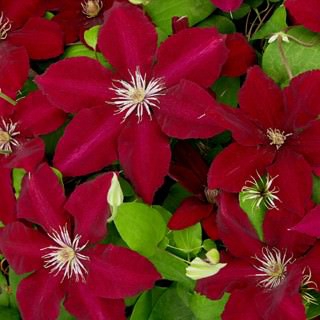 Very often, gardeners give positive feedback about Clematis Westerplatte (Westerplatte). This variety was bred by Polish breeders, recommended for growing near supports, arbors, trellises, fences.
Very often, gardeners give positive feedback about Clematis Westerplatte (Westerplatte). This variety was bred by Polish breeders, recommended for growing near supports, arbors, trellises, fences.
The culture is a plant with stems about 2 m long, which can also cling to small trees and shrubs. Sparkling flowers have a bright red color, large size, silky petals, dark red stamens. The variety was awarded a gold medal at the Plantarium 1998 exhibition.
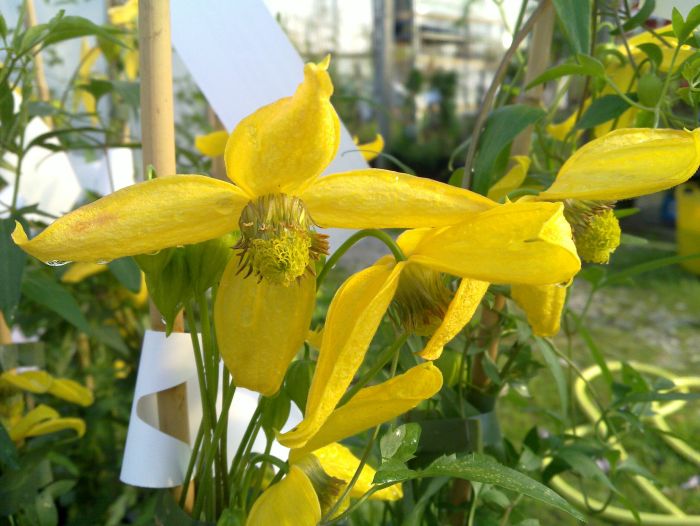 It will not be difficult for a competent florist to grow clematis Helios from seeds purchased at a specialized outlet or collected on their own. This variety is a vigorous plant with 3 m long stems that needs to be planted in well-lit places.
It will not be difficult for a competent florist to grow clematis Helios from seeds purchased at a specialized outlet or collected on their own. This variety is a vigorous plant with 3 m long stems that needs to be planted in well-lit places.
Clematis Helios in the period June - August delights with many small light yellow flowers, the petals of which are effectively turned outward. The culture is suitable for planting close to supports, fences, feels great in a flower bed.
Early, large-flowered clematis Duchessof Edinburgh (Duches Edinburgh) amazes with the exquisite beauty of double, spherical flowers that bloom on last year's shoots in May - June. The stems of the plant reach a height of 2 - 3 m. In July - August, the variety pleases with single flowers. The optimal place for planting a plant will be a sunny area, which provides for the presence of support - gazebos, trellises, nets.
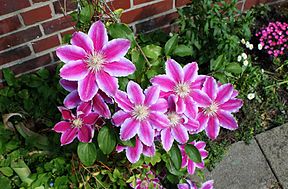 The original clematis Dr Ruppel (Dr. Ruppel) is able to change the color of the buds depending on the lighting. Large flowers of the plant (12 cm in diameter) may have a pink color with a fuchsia stripe. Also, their colors can be lavender with a pink stripe. Over time, the flower becomes rich lavender. The first flowering of the culture can be admired in the spring. The second falls on the period August - September. Spring flowers are semi-double. The height of the stem of the culture is about 3 m.
The original clematis Dr Ruppel (Dr. Ruppel) is able to change the color of the buds depending on the lighting. Large flowers of the plant (12 cm in diameter) may have a pink color with a fuchsia stripe. Also, their colors can be lavender with a pink stripe. Over time, the flower becomes rich lavender. The first flowering of the culture can be admired in the spring. The second falls on the period August - September. Spring flowers are semi-double. The height of the stem of the culture is about 3 m.
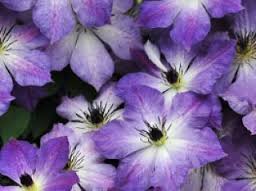 Large-flowered, late clematis Cloudburst is a new variety bred by specialists from the nursery of Szczepan Marchinsky, Poland. The variety immediately earned the approval of flower growers from different countries, was awarded a gold medal at the Flowers Expo 2014 exhibition.
Large-flowered, late clematis Cloudburst is a new variety bred by specialists from the nursery of Szczepan Marchinsky, Poland. The variety immediately earned the approval of flower growers from different countries, was awarded a gold medal at the Flowers Expo 2014 exhibition.
Giving feedback on Clematis Cloudburst, gardeners note the formation of shoots from a length of 2.5 m by the plant. The flowers of the culture are light pink-purple, having a white middle, pink veins. Their diameter is 10 - 12 cm. Petals in the amount of 4 - 6 pcs. have a diamond shape, pointed, wavy edges. Stamen stamens are cream and their anthers are black. Chic clematis Cloudburst shows flowering in the period June - September.
Late, large-flowered clematis Comtesse de Bouchaud (Comtesse de Bouchot) is a strong culture 3 - 4 m high. The flowers of the plant have pink petals, cream stamens. The flowering periods of the variety are observed in June - July, August - September. Comtesse de Bouchot can be grown near fences, trellises, arbors, walls, natural supports (small shrubs, trees), as well as in containers placed on terraces, balconies.
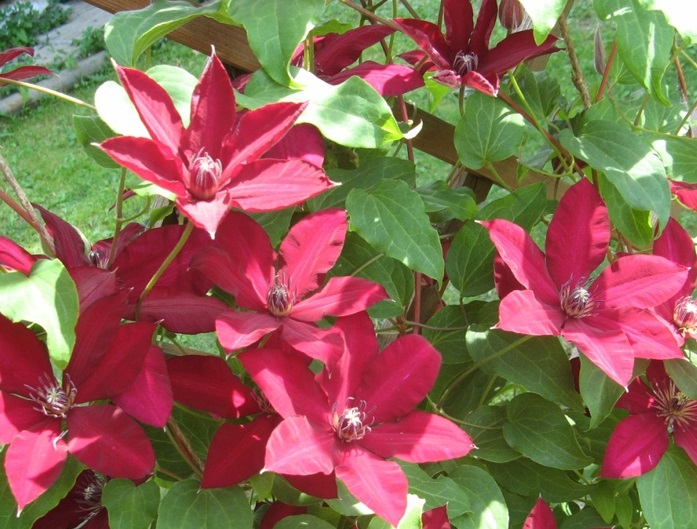 Luxurious clematis Long Fire (Long Fire) evokes associations with a bright flame, for which it got its name. It impresses with abundant flowering from May to September. The stems of the culture are very compact, their length is about 1.5 m. The plant likes both the sun and partial shade.
Luxurious clematis Long Fire (Long Fire) evokes associations with a bright flame, for which it got its name. It impresses with abundant flowering from May to September. The stems of the culture are very compact, their length is about 1.5 m. The plant likes both the sun and partial shade.
The flowers are large (16 cm in diameter) with a bright crimson color, velvety petals, a light stripe in the center. The graceful stamens have white filaments and purple anthers. The plant clings to supports (arbors, trellises, nets) through leaf roots. The culture is suitable for container growing.
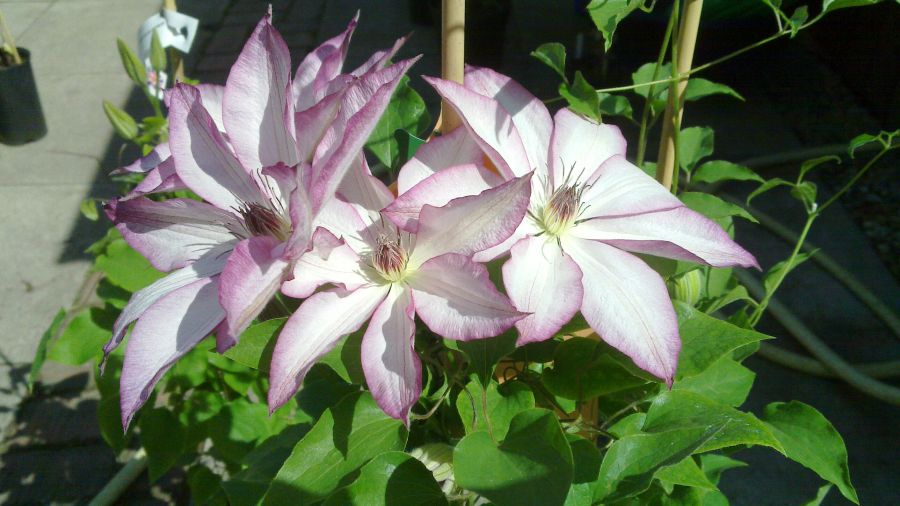 Early, large-flowered clematis Omoshiro (Omoshiro) is Japanese variety loved by many gardeners. The stems of the plant are 2-3 m long. Varietal flowers (16 cm in diameter) are white or light pink. Petals (6 - 8 pieces) are pink or purple-pink at the edges. The stamens have cream filaments, purple-red anthers.
Early, large-flowered clematis Omoshiro (Omoshiro) is Japanese variety loved by many gardeners. The stems of the plant are 2-3 m long. Varietal flowers (16 cm in diameter) are white or light pink. Petals (6 - 8 pieces) are pink or purple-pink at the edges. The stamens have cream filaments, purple-red anthers.
Omoshiro blooms twice: in May - June, and also in August - September. The bush can be planted close to a trellis, net, other garden support, or in a container on a balcony or terrace.
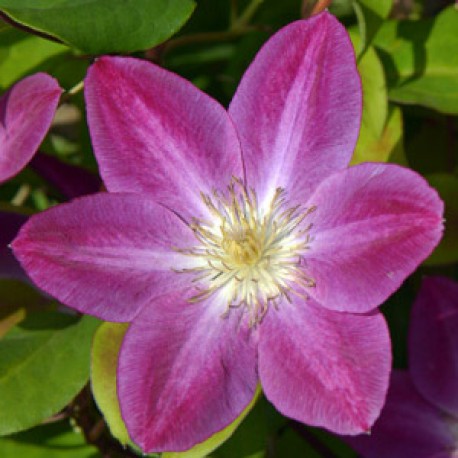 The Polish varietal clematis Change of Heart is a strong plant with stems up to 2 m long, covered with green, shiny leaves.
The Polish varietal clematis Change of Heart is a strong plant with stems up to 2 m long, covered with green, shiny leaves.
Change of Hart is characterized by the formation of many purple-red flowers (with a diameter of 10 cm or more). Gradually, the color of the petals changes to red-pink, their edges acquire a pink-blue color, and a light stripe (white at the base) is visible in the middle. Stamens have green filaments, yellow anthers. Flowering culture occurs twice per season.
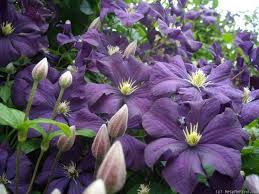 Beautiful clematis Etoile Violette is an unpretentious, strong plant with shoots about 3 m long. The variety is characterized by abundant flowering in the period June - September.
Beautiful clematis Etoile Violette is an unpretentious, strong plant with shoots about 3 m long. The variety is characterized by abundant flowering in the period June - September.
By publishing reviews of Clematis Etoile Violet, gardeners focus on the splendor of the many dark purple flowers of the culture. Etoile Violette is suitable for shelters, can be planted near various fences, supports in the garden. The flower is also used as a groundcover.
Since there are seeds of various varieties, clematis hybrids on sale, it is not difficult to pick up and purchase bags with the right planting material.
This makes it possible to obtain original, beautiful crops that will compare favorably with neighboring plantings. 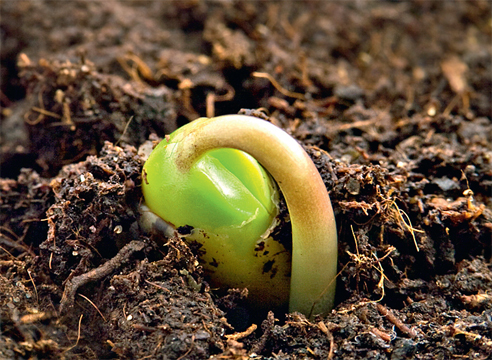 Seed-grown plants show good fruiting, which makes it possible to collect new seed material, which is then often used as a rootstock when grafting heat-loving varieties.
Seed-grown plants show good fruiting, which makes it possible to collect new seed material, which is then often used as a rootstock when grafting heat-loving varieties.
Among the shortcomings of the method, it is worth noting its rather high labor intensity and troublesomeness. In addition, seed breeding is not a guarantee that the resulting plants will retain the best qualities of the mother specimens.
The most successful is seed breeding of plants with small flowers. It is also worth using this method if the florist is replenishing his species collection or conducting home breeding events. Lots of useful information in this article:
In addition to the official botanical name, clematis has several other names: grandfather's curls, clematis, warthog.
The plant attracts flower growers with beautiful flowers on climbing vines.
However, it is not always possible to get a seedling of a plant and there is a question about growing clematis from seeds.
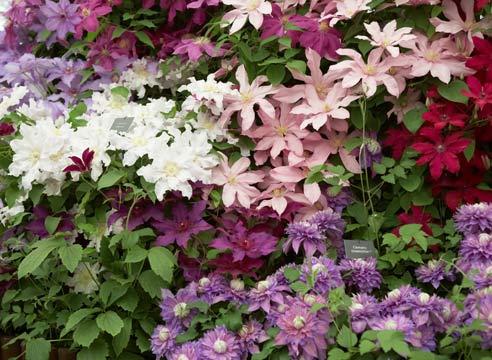
Clematis are most often herbaceous climbing plants with liana-like climbing stems. There are also creeping and upright species.
They are distributed almost everywhere except the polar regions. They appeared in culture for the first time in Japan. Since the 16th century, they have been grown in Europe, and in Russia they began to get carried away from the end of the 18th century.
It is important to know that many species are very different from each other. In the herbaceous species of clematis straight, as well as in the Manchurian and Texas, ground shoots die off annually in late autumn.
In semi-shrub clematis hogweed and whole-leaved, the lower part of the shoots becomes woody and persists for several seasons.
Lignified shoots of clematis shrub are preserved in winter period. Creepers of purple clematis and vine-leaved clematis master vertical supports, climbing them with the help of petiole leaves.
In various types of clematis, it can be both rod and fibrous. The stems are also different: grassy representatives have rounded green stems, and woody stems - in the form of polyhedrons with brown bark.
The leaves, simple or complex, are arranged in pairs, there are species with purple-colored leaf plates.
There are plants with both simple and double flowers. A simple flower with numerous stamens and pistils in the center looks unusual; they form the so-called spider, which differs in color from the color of the petals. Simple flowers can have 4-8 petals, while double flowers can have up to seven dozen.
Clematis feel great in one place for at least two decades. The fruit of clematis has an outgrowth in the form of a spout and a device for wind dispersal.
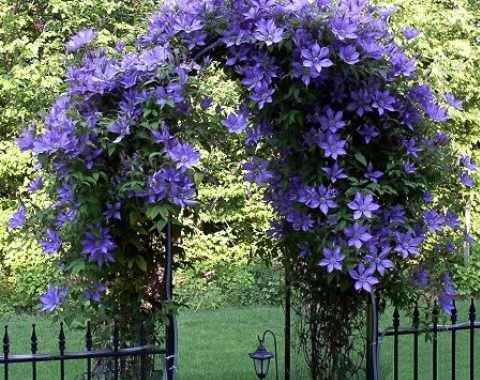
Before sowing in the ground, clematis seeds need special preparation - stratification, which several times reduces the time from sowing to the appearance of sprouts. Otherwise, the seeds can lie in the soil for almost a year and a half.
Preliminary preparation is carried out in several stages. At the first stage, the seeds must be soaked for five days in water, which must be systematically changed to fresh water.
At the second stage, the seeds are sown in containers with soil consisting of earth, sand and peat. The planting depth of large seeds is two centimeters, medium seeds are one cm, and small seeds are no deeper than 0.8 mm.
After sowing, the containers must be kept for ten days in a warm place, where the temperature is not lower than 18 and not higher than 22 degrees.
After that, seedling boxes are placed on the bottom shelf in the refrigerator or covered with snow in the garden for a period of 90 days. In the spring, after the end of stratification, shoots appear after about two to three weeks.
You can do it in another way. Sow the seeds at the beginning of winter in containers with moist, fertile soil. Then place them on a glazed loggia, in a greenhouse without heating.
With the onset of spring, bring the containers into a warm place and place them on a lighted windowsill. With regular watering, the seeds will begin to germinate in 20 days. If this does not happen, do not rush to part with the crops.
Shoots can appear throughout the summer if the containers are kept in a cool place, sometimes the seeds are dormant until the next spring.
When sowing small seeds, you can limit yourself to pre-soaking. When leaves appear, the plants are transplanted, sometimes immediately to a permanent place, sometimes or in a separate container.
As soon as the second pair of leaves appears on young plants, they must be transplanted into separate pots, and if the weather allows, then immediately to a permanent place, especially since frequent transplants negatively affect forms with taproots.
The plant needs a spacious planting hole with a good drainage layer. Fertile soil 30 - 40 cm high is poured onto it with a mound and a clematis seedling obtained from seeds is installed on top.
Clematis is a fairly large climbing plant that is grown in home gardens, in greenhouses or at home. There are different varieties. For the home, as a rule, the smallest ones are used, since the plant tends to bushiness and growth. Clematis has rather large flowers in the shape of a star and is able to decorate any room with itself, harmoniously fitting into the interior.
Exists a large number of clematis varieties. As part of this story, we will be interested in classifying them by seed size, since the time of appearance of the first shoots depends on this. Large seeds germinate for a long time - sometimes it takes up to 450 days, medium seeds - about 1-2 months, small seeds - from 10 days to two months. In this regard, an amateur grower will have to have a certain amount of patience in order to decorate his house with this exotic plant. However, most experienced breeders recommend the use of biogrowth stimulants, which can significantly reduce the time of germination and the appearance of the first shoots. And now it’s worth moving on to practice and talk about how to grow clematis from seeds at home.
As a rule, clematis is used to decorate hedges and the exterior of buildings, but, as practice shows, this plant fits well into the interior of large rooms.